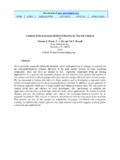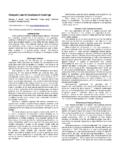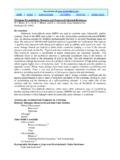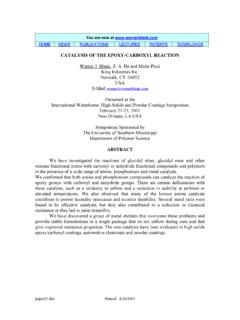Transcription of FORMULATING POLYURETHANE DISPERSIONS …
1 You are now at HOME NEWS PUBLICATIONS LECTURES PATENTS DOWNLOADS FORMULATING POLYURETHANE DISPERSIONS Werner J. Blank King Industries Inc. Norwalk CT ABSTRACT POLYURETHANE DISPERSIONS are being used increasingly in industrial applications. Because of the high cost of these DISPERSIONS they are being employed where the performance achieved with waterborne acrylic, alkyd, polyester and epoxy resins is not adequate, or they are being used in combination with other resins to improve certain properties. I will discuss the problems associated in FORMULATING POLYURETHANE DISPERSIONS , how these systems can be pigmented, and crosslinked with either melamine or polyisocyanate crosslinker and how to catalyze these formulations. In addition I plan to discuss how to combine these POLYURETHANE DISPERSIONS with other polymer systems.
2 INTRODUCTION Solvent-borne POLYURETHANE polyols are used in many industrial applications where high abrasion resistance, elastomeric properties, and high extensibility at low temperature are the performance -14 Most of the solvent-borne PUR polyol coatings are relatively high in solvent content and do not qualify in low VOC applications. For this reason, there is an increased interest in water-borne crosslinked PUR coatings. POLYURETHANE DISPERSIONS are being synthesized by different methods and processes compared to acrylic or other vinyl dispersion polymers. Most of the acrylic and vinyl DISPERSIONS are produced by an emulsion polymerization process in the presence of an external surfactant or colloidal stabilizer. Most of the POLYURETHANE DISPERSIONS on the other hand are produced by a prepolymer process15 which involves the preparation of a low molecular weight isocyanate terminated ionomer, either in bulk or in a solvent, dispersing this ionomer in water followed by chain extension.
3 To be able to chain extend the polymer in water, the low molecular weight prepolymer is prepared from a diol, an ionic monomer and an excess of diisocyanate. After dispersion of the ionomer in water, chain extension takes place by reaction of the isocyanate end groups with water and reaction of the resulting amine with more isocyanate, or by addition of a di functional primary amine to the dispersed POLYURETHANE . Most acrylic and vinyl polymers are produced with a low amount of ionic co-monomer. Polymerization of the dispersion is carried out in most systems under acidic pH condition and the ionic groups on the polymer are not ionized. After polymerization the DISPERSIONS are neutralized and ionized and contribute to improved stability of the dispersion polymer to freeze thaw, to pigmentation and shear.
4 In a POLYURETHANE prepolymer the ionic groups are placed on the backbone in a random placement. During dispersion and neutralization these ionic groups are solvated by the water and orient themselves as much as possible onto the outside of the polymer micelle. Because of restriction in mobility this is an incomplete process. Many ionic groups can be buried in the polymer particle after the dispersion process16. We also prepared low molecular weight POLYURETHANE DISPERSIONS by a non-isocyanate process which utilized a urethane diol which was transesterified with a polyester resin and functionalized with carboxyl groups in a second reaction step17. These carboxyl and hydroxyl functional polyester-urethane resins have a MW of between 1000 to 5000. These resins can be either used in a solvent borne coating or can be dispersed in water in the presence of an amine.
5 In the acrylic polymerization process most if not all of the ionic groups migrate to the surface of the particle, making the center hydrophobic and essentially devoid of any functional groups. Typical polymer DISPERSIONS are characterized by a minimum film formation temperature (MMFT). This is the lowest temperature at which the dispersion polymer particles can coalesce and form a continuous film. For most acrylic DISPERSIONS this MMFT is close to the glass transition temperature (Tg) or slightly below the Tg. Coalescence requires the deformation of the polymer particles and inter diffusion of the polymer chains. The MMFT can be lowered in a dispersion by the addition of a solvent which acts as a temporary plasticizer for the polymer. In addition film formation can be lowered. Film formation of colloidal waterborne resins is less dependent on the glass transition temperature of the polymer and these polymers can form a film substantially below the Tg of the polymer.
6 In this case the section of the polymer containing ionic groups are being plasticized by water during film formation. Most so called "water soluble" polymers fall into this category. Most POLYURETHANE dispersion fall into the category of colloidal DISPERSIONS or ionomer. The ionic layer on the particle surface and also some hydrophilic groups within the particle are plasticized by the water, therefore film formation can take place above the glass transition temperature (Tg) of the polymer. POLYURETHANE DISPERSIONS offer a unique combination of properties, flexibility, toughness, high abrasion resistance and if aliphatic excellent light stability. Compared to acrylic polymers, however, polyurethanes suffer from poorer water, chemical resistance and hydrolytic stability.
7 For most industrial applications an POLYURETHANE DISPERSIONS can be improved by crosslinking of the polymer. Some of the POLYURETHANE properties, however, can be incorporated into other polymers by either blending or by co-reaction. EXPERIMENTAL MATERIALS The low molecular weight hydroxyl and carboxyl functional POLYURETHANE DISPERSIONS (PUD) were prepared by a non-isocyanate process. The higher molecular weight DISPERSIONS were prepared by a conventional isocyanate prepolymer process or commercial materials were used. The polyester urethanes were dispersed in water after addition of an amine. The characteristics of a low MW PU DISPERSIONS used in the pigment dispersion studies and in some of the crosslinking studies is shown in Table 1 and 2. PIGMENT DISPERSIONS Both organic and inorganic pigments were dispersed in the PUD XM-231118.
8 The pigment is dispersed in the PUD additional water or amine is added and the paste is dispersed. The carbon black is ground in a steel ball mill for 24-72 hours depending on the degree of jetness and dispersion desired. The organic pigments were dispersed first on a high speed dissolver and then ground in a porcelain or ceramic ball mill. The titanium dioxide was dispersed in a high speed mixer for 15-20 minutes. A Hegman fineness of 7+ is easily achieved. CROSSLINKING OF PUD Crosslinking in this study was carried out with a water dispersible polyisocyanate crosslinker19. This crosslinker was modified with nonionic sites to improve dispersibility20 (Table 3). The crosslinked films were tested for hardness (Pendulum), solvent resistance (MEK rub) and also for gloss.
9 Film properties as a function of cure time and also pot life of the formulation was investigated. The formulations were studied with and without any additional catalyst. RESULTS AND DISCUSSION PIGMENT dispersion In testing the quality of the dispersion it is important to test the dispersion after letdown with a binder. Particle size analysis of the PUD XM-2311 pigment dispersion show a particle size of about 1 micron. The pigment is dispersed within the hydrophobic phase of the POLYURETHANE dispersion . This behavior can explain why pigment DISPERSIONS with XM-2311 can be formulated at a high solids. Picture 1 shows a pigment dispersion prepared according to Table 4 with a pigment to binder ratio of 1/1 using a Irgazin DPP BO red pigment and a grinding time of 16 hours on a pebble mill and let down with a PUD dispersion .
10 The same pigment dispersion diluted with water shows particles of about 1 micron, dilution with a solvent shows agglomeration of particles (Picture 2). Besides Irgazin red, which is a rather large particle size pigment a wide selection of organic and inorganic pigments were dispersed. The results of this dispersion work are shown in Table 5. CROSSLINKING WITH POLYISOCYANATE In this study we investigated the crosslinking reaction and catalysis of a hydroxyl/carboxyl functional PUD21 with a water dispersible polyisocyanate19. One of the major problems in crosslinking of hydroxyl functional polymers in water is the side reaction between the isocyanate groups and water leading to the formation of polyureas and a decrease in crosslinking density. Almost all waterborne formulations of polyols with polyisocyanates are significantly overdosed with polyisocyanate, often a 100 % excess of polyisocyanate is used.





